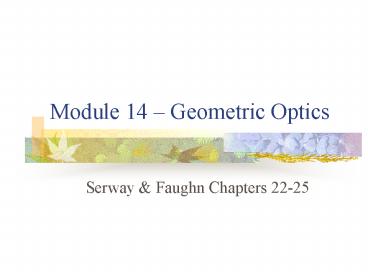Module 14 Geometric Optics - PowerPoint PPT Presentation
1 / 19
Title:
Module 14 Geometric Optics
Description:
Light is an electromagnetic wave. Geometric optics ignores diffraction ... Snell's Law for Refraction. Normal. n2 (air) n1 (glass) Critical Angle Equation. Normal ... – PowerPoint PPT presentation
Number of Views:128
Avg rating:3.0/5.0
Title: Module 14 Geometric Optics
1
Module 14 Geometric Optics
- Serway Faughn Chapters 22-25
2
Module Study Objectives
- Reflection
- Refraction
- Image formation by lenses and mirrors
- Optical instruments
3
Introduction
- Light is an electromagnetic wave
- Geometric optics ignores diffraction
- How does light behave in different media?
- How are images formed?
4
Reflection
- Angle of incidence equals angle of reflection.
5
Refraction
- Some light may be transmitted from one medium to
a second - Average speed at which light travels will change
- Frequency does not change
6
Index of Refraction
- Ratio of speed of light in a vacuum to speed
measured in material.
7
Critical Angle
- Total internal reflection occurs at critical
angle (or greater).
air
glass
Normal
8
Lateral Magnification
- Ratio of image height to object height.
9
Virtual Image
- Real image results from converging rays
- Virtual image results from diverging rays
diverging rays
Water droplet
10
Focal Length
- Distance from focal point to the mirror or lens.
11
The Law of Reflection
Normal
air
water
12
Snells Law for Refraction
Normal
n2 (air)
n1 (glass)
13
Critical Angle Equation
Normal
n2 (air)
n1 (glass)
14
Mirror / Thin Lens Equation
15
Lateral Magnification Equation
Front
Back
F
ho
Image
Object
hi
di
do
16
Lens Makers Equation
Radius of curvature R2
Radius of curvature R1
F
Image
Object
Refractive index n
f
17
Optical Instruments
- Eyes
- Cameras
- Spectacles (glasses)
- Telescopes
- Microscopes
- Binoculars
- Photocopiers
- Etc
18
Conclusion
- Reflection and refraction are governed by simple
mathematical laws - These laws can be used to determine the location,
size and type of image formed by a lens or mirror - These laws govern the design of a variety of
optical instruments
19
End of Module
- Any questions?































